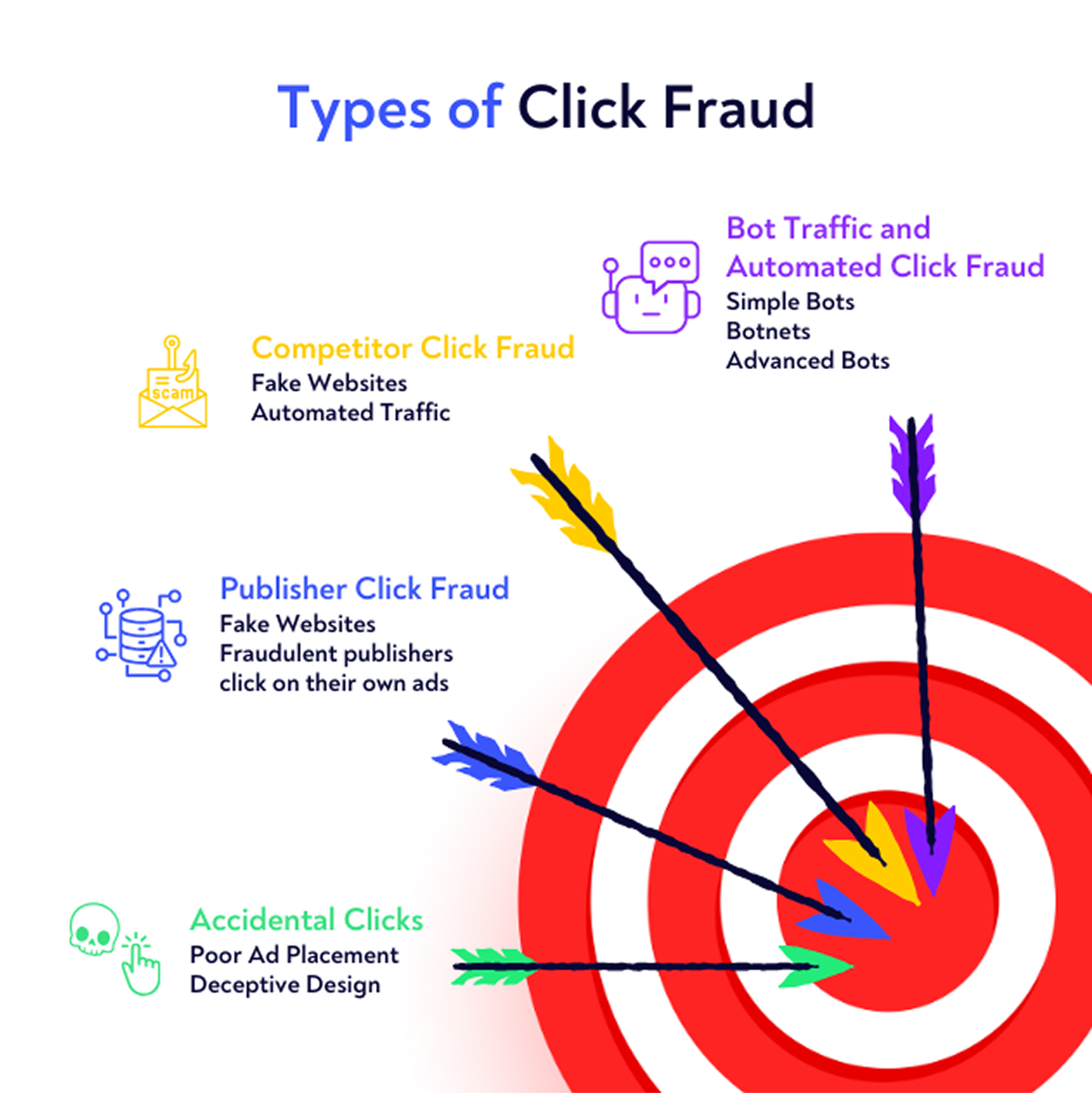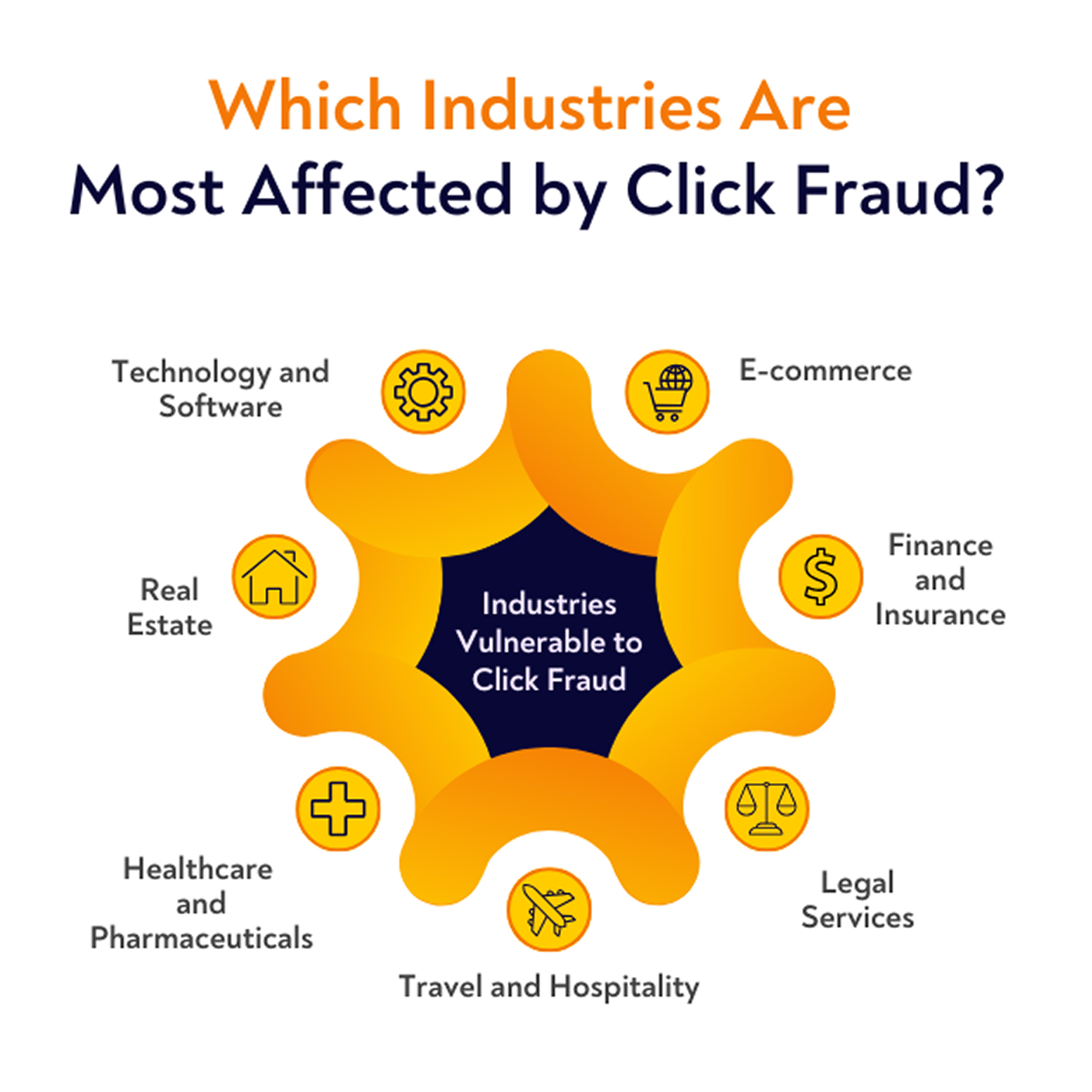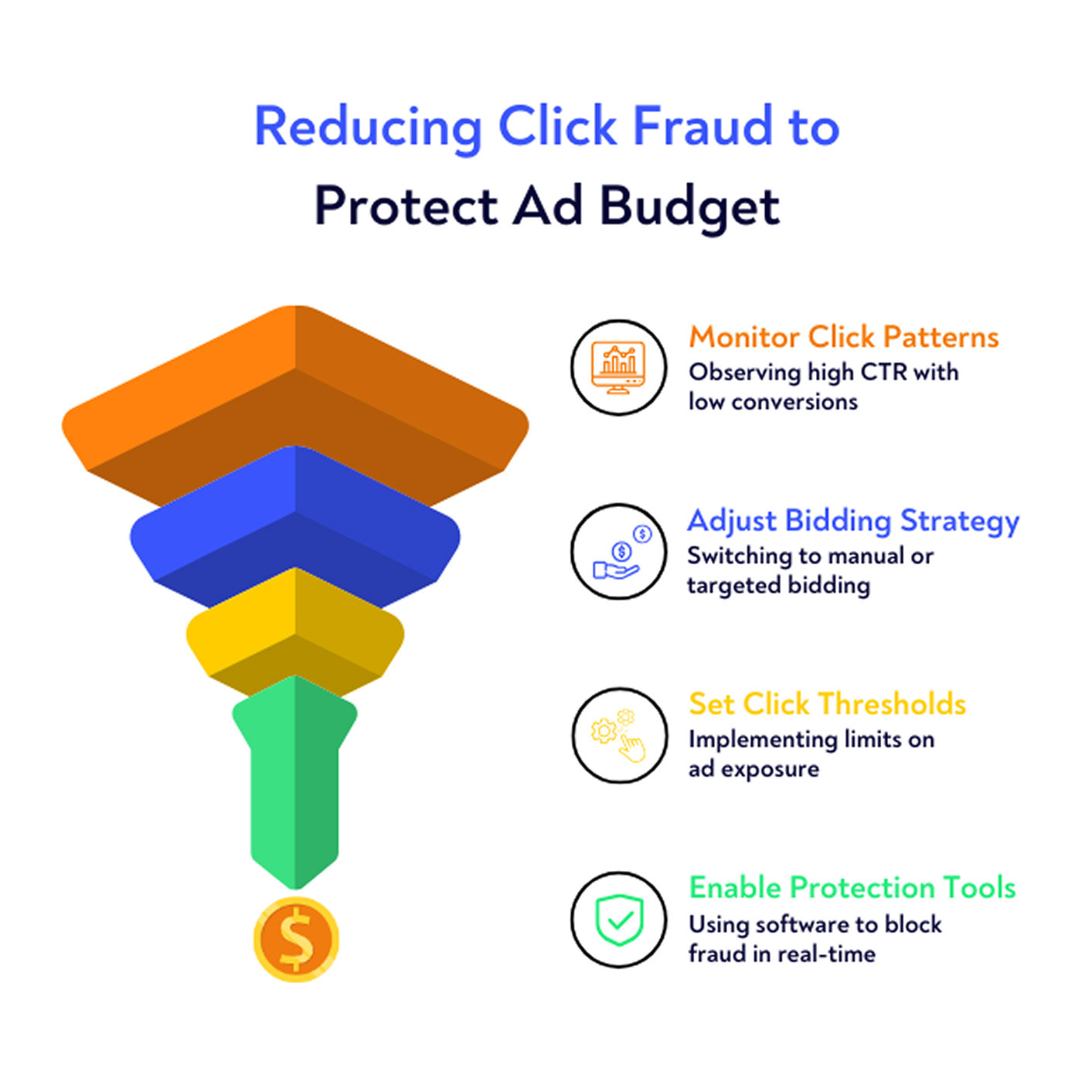What is click fraud? How it works & how to prevent it
Are your campaigns generating a lot of clicks but barely converting? Or maybe you're seeing traffic from regions you never targeted? If these situations sound familiar, your pay-per-click ads might be falling victim to something called click fraud.
Click fraud is one of the biggest hidden threats in digital advertising. It drains ad budgets, skews performance data, and prevents businesses from reaching real customers. Many advertisers assume that platforms like Google Ads automatically filter out fake clicks, but the reality is far more complex. Fraudulent activity is constantly evolving, with bots and bad actors finding new ways to manipulate ad traffic.
So, what exactly is click fraud, and why is it such a growing problem? Let’s break it down.
What is Click Fraud?
Click fraud is the practice of fraudulently clicking on online pay-per-click ads with the intent to waste advertisers' budgets, manipulate ad performance, or damage a company’s reputation. These fake clicks come from competitors, automated bots, or even unethical publishers trying to boost their ad revenue.
Unlike accidental clicks, click fraud is deliberate. It messes up campaign data, increases costs, and reduces ROI—hurting businesses that rely on paid ads for growth. And the problem keeps growing. With the rise of automation and AI-powered bots, fraudulent clicks are becoming more sophisticated and, therefore, harder to detect.
According to Juniper Research, click fraud already costs businesses over $100 billion annually—and this number is expected to hit $172 billion by 2028. The impact is massive, but understanding how click fraud works is the first step in protecting your ad spend.
How Does Click Fraud Work?
Click fraud happens when ads receive fake, non-genuine clicks designed to drain budgets, manipulate ad performance, or generate illegitimate revenue. These clicks may look real, but they don’t come from potential customers—they come from fraudsters, bots, and bad actors with malicious intent.
To execute click fraud, perpetrators use automated scripts, large-scale human networks, or even unethical competitors. Some fraudsters set up entire operations to flood ads with invalid clicks, while others use sophisticated techniques to mimic human behavior and bypass detection.
One of the biggest challenges? Click fraud is constantly evolving. Fraudsters hide behind proxies, VPNs, and IP spoofing, making it harder to track them down. Some advanced bots even engage with multiple elements on a page—scrolling, hovering, and clicking—before interacting with an ad, making them look like real users.
Victims of click fraud, businesses waste money on fake engagement, lose valuable ad placements, and struggle to trust their campaign data. And as long as digital advertising remains lucrative, click fraud isn’t going anywhere.
How Much Damage Does Click Fraud Do?
Click fraud isn’t just a minor annoyance—it’s a multi-billion-dollar problem that deeply affects marketing strategies and reduces businesses’ ROI. As search ad spending hit $190.5 billion at the end of 2024 and overall digital advertising spending continues to grow, so does the financial impact of fraudulent clicks.
We’ll let the numbers speak for themselves:

The Financial Toll of Click Fraud
- $88 billion was lost to digital ad fraud in 2023, and more than $100 billion in 2024, with projections reaching $172 billion by 2028, according to Juniper Research.
- The same study revealed that North America is predicted to suffer the most, with projected losses of $72 billion by 2028, followed by China and the Far East ($34B) and Western Europe ($29B).
- Click fraud is growing at an alarming 14% per year, increasing the risks for advertisers.

Impact on Campaign Performance & ROI
- Nearly 18% of all ad impressions are fraudulent, wasting ad budgets on fake engagement.
- A staggering 49.6% of all internet traffic in 2023 came from bots—marking the highest level ever recorded. Worse, 32% of that traffic was from malicious bots designed to manipulate online advertising.
- The same company detected that invalid clicks made up 34% of global desktop web traffic in late 2023, making it harder for advertisers to reach real potential customers.
- 26% of global clicks were invalid, according to findings by Pixalate for Q1 2024.
- 42% of marketers cite inaccurate performance metrics as a major challenge caused by fraudulent traffic.
As the numbers showed, the problem will only get worse. The rise of automated click fraud means fewer real users are seeing ads, leading to wasted budgets and misleading analytics. Marketers struggle to optimize campaigns when fraud distorts engagement metrics, making it harder to allocate budgets effectively.
Try our Click Fraud Calculator for free and discover how much you could save by protecting your ads.
The Different Types of Click Fraud
Click fraud comes in many forms, each with its own methods and motivations. While some fraudsters act out of direct competition, others exploit ad networks for financial gain or simply take advantage of poor ad placements.
Here are the four most common types of click fraud:
Competitive Click Fraud: When competitors repeatedly click your ads to drain your budget and knock you out of the auction.
Bot Clicks: Automated scripts or malware that generate fake clicks at scale, often mimicking real user behavior.
Click Farms: Low-cost human workers are paid to manually click on ads, making ad fraud harder to detect.
Accidental Clicks: Unintentional taps or swipes, usually caused by poor ad placements or misleading designs.
Now, let’s look at each type in more detail and how they can quietly drain your ad budget.

1. Competitor Click Fraud
Who’s behind it? Your competitors.
Why do they do it? To drain your ad budget and push you out of the market.
Competitor click fraud happens when businesses or individuals intentionally click on a rival’s ads to exhaust their daily budget. Once the budget runs out, the ad stops showing—giving the competitor an advantage.
- Small businesses in highly competitive industries (like legal services, real estate, and insurance) are frequent targets.
- Some companies use manual clicking, while others hire click farms or use automated bots to inflate fraudulent activity. Click farms are large groups of low-paid workers clicking ads to simulate real engagement—are often used to bypass fraud detection systems.
- This tactic artificially increases CPC (cost-per-click) and makes it harder for advertisers to get a return on their investment.
2. Bot Clicks
Who’s behind it? Fraudsters using automation.
Why do they do it? To simulate real traffic and steal ad spend—at scale.
Bot clicks are generated by automated programs designed to mimic human behavior. These bots can load pages, click on ads, and even simulate mouse movements and scrolls, making them difficult to detect.
Bots can operate 24/7, generating thousands of fake clicks in a short period.
Some are simple scripts, while others are part of massive botnets spread across infected devices.
They’re often used to manipulate campaign performance metrics, burn budgets, or generate fraudulent revenue for shady publishers.
3. Click Farms
Who’s behind it? Organized networks of low-paid workers
Why do they do it? To create fake engagement that looks real to ad platforms.
Click farms are groups of real people hired to click on ads, visit pages, or interact with content. Unlike bots, their human activity makes them much harder to detect.
Click farms are commonly found in regions with low labor costs and high mobile phone usage.
Their clicks often go unnoticed by automated fraud detection systems, which are tuned to spot non-human behavior.
Some click farms are contracted by shady publishers looking to boost ad revenue or by competitors running more elaborate fraud schemes.
4. Accidental Clicks
Who’s behind it? No one malicious—just bad UX or ad placement.
Why does it happen? Because users unintentionally tap on ads they didn’t mean to click.
Not all click fraud is intentional. Sometimes, accidental clicks are caused by poorly placed ads, misleading formats, or tricky mobile layouts, especially on gaming or entertainment apps.
These clicks rarely result in conversions and waste ad budgets quickly.
They distort performance data, making it harder to optimize campaigns.
Ad networks sometimes benefit from these clicks, so they may not be motivated to prevent them entirely.
Which Industries Are Most Affected by Click Fraud?
Click fraud disproportionately impacts industries where high competition and high CPC are prevalent. These industries often rely heavily on paid advertising to drive traffic, leads, and sales, making them prime targets for fraudulent activity.
The sectors most affected by click fraud include:

1. E-commerce
E-commerce businesses frequently compete for top ad placements on high-value keywords like product names, brands, and categories. With high CPCs and fierce competition, competitors may engage in click fraud to drain budgets or sabotage campaigns.
In this industry, fraudulent clicks can lead to wasted ad spend, reduced ROI, and skewed campaign data, making it harder to optimize performance.
2. Finance & Insurance
This sector is especially targeted because keywords related to loans, insurance, credit cards, and financial services are extremely expensive. Fraudsters target these industries to exhaust ad budgets quickly. And, unfortunately, high CPCs mean even a small amount of click fraud can result in significant financial losses.
3. Legal Services
Law firms often bid on competitive keywords like “personal injury lawyer” or “divorce attorney,” which can cost hundreds of dollars per click. Competitors or bots may click on these ads to deplete budgets. Click fraud leads to wasted ad spend and reduced lead generation, which directly affects legal services companies' revenue.
4. Travel and Hospitality
Travel-related keywords (e.g., “cheap flights,” “hotel deals”) are highly competitive and expensive. Competitors or malicious actors may use click fraud to disrupt campaigns and drain budgets, especially during the highly competitive peak travel seasons.
5. Healthcare & Pharmaceuticals
This is another example of a sector with high competition and high CPCs. Keywords related to medical treatments, prescriptions, and healthcare services are costly and highly competitive. Click fraud can lead to wasted budgets and fewer genuine leads, affecting patient acquisition and revenue for doctors and other professionals, clinics, and hospitals relying on PPC ads.
6. Real Estate
Real estate agents and companies often bid on location-based keywords (e.g., “homes for sale in [city]”), which are expensive and competitive. Fraudulent clicks can drain budgets and reduce the effectiveness of lead generation campaigns.
7. Technology & Software
Tech companies frequently bid on high-value keywords related to software, apps, and IT services. Competitors may use click fraud to disrupt campaigns. The consequences of these malicious acts are wasted budgets and reduced ROI on ad spend.
Real Examples of Click Fraud
Click fraud is a pervasive issue that affects businesses of all sizes, from small startups to industry giants. Below are real-world examples that highlight how fraudsters manipulate PPC campaigns and the devastating impact they can have on businesses.
Uber’s $100 Million Click Fraud Scandal
Uber lost over $100 million to a sophisticated click fraud scheme. This story was shared by Kevin Frisch, Uber’s former head of performance marketing and CRM, on the Marketing Today podcast.
During a routine review of their ad performance, Uber made a shocking discovery: Even after cutting their ad budget by $100 million, the number of app installs remained virtually unchanged. This inconsistency prompted a deeper investigation, which uncovered a scheme known as attribution fraud.
Essentially, Uber was being charged for app installs that happened organically, not through paid ads. The ad network had manipulated the data to make it appear as if the installs were driven by their campaigns.
This case sheds light on how attribution fraud operates. Since the data often looks legitimate, it can go unnoticed without thorough analysis. Businesses must carefully monitor their click, conversion, and acquisition metrics to spot discrepancies and protect their ad budgets from such scams.
Forbes and the MFA Subdomain Scandal
A report from Adalytics, an ad quality firm, revealed in April 2024 that Forbes systematically misled advertisers into believing they were buying media on Forbes.com when they were actually purchasing ad space on a secret, spammy ‘made for advertising’ (MFA) subdomain. Forbes shut down the subdomain following inquiries from The Wall Street Journal.
The www3.forbes.com subdomain repurposed Forbes articles into low-quality formats like listicles and slideshows, bombarding readers with over 200 ads per page view—far more than the 3–10 ads typically seen on the main Forbes site. The subdomain didn’t have subscription paywalls and wasn’t indexed by search engines, making it inaccessible via organic search.
Roughly 70% of traffic to the subdomain came from clickbait ads placed by content recommendation services like Outbrain and Taboola. Hundreds of major brands, including Microsoft, Disney, JPMorgan Chase, Johnson & Johnson, Mercedes Benz, and Ford, unknowingly bought ad space on the subdomain, believing they were purchasing premium inventory on Forbes.com. One major consumer health brand discovered that 28% of their impressions thought to be on Forbes.com were actually served on the subdomain.
Forbes relied on ad verification firms for its primary site. However, these tools weren’t used on the subdomain, allowing Forbes to obscure the low-quality inventory from advertisers.
Forbes defended its credibility, stating that the subdomain represented only 1% of its overall user base and was developed as an alternative way to consume existing content. However, the company chose to shut down the subdomain to “eliminate any potential confusion.” Forbes also blamed Media.net, its adtech partner, for misleading advertisers by incorrectly declaring the subdomain as Forbes.com.
How Click Fraud Has Evolved in 2025 & What’s Next
Click fraud became even more sophisticated in 2025, with fraudsters leveraging advanced technologies like AI and machine learning to bypass traditional detection methods. As advertisers invest more in digital advertising, fraudsters are finding new ways to exploit vulnerabilities in PPC campaigns. Here’s a look at the latest trends in click fraud:
- AI-Powered Bots: Fraudsters are now using AI to create bots that mimic human behavior more convincingly. These bots can simulate mouse movements, scrolling, and even random pauses, making them harder to detect.
- Attribution Fraud 2.0: Fraudsters have refined attribution fraud techniques, using AI to manipulate data and make fraudulent clicks appear legitimate. For example, they can now simulate multi-touch attribution paths to deceive advertisers into believing their ads drove conversions.
- Geo-Targeting Exploits: Fraudsters are targeting high-CPC regions with greater precision, using AI to identify and exploit geographic vulnerabilities in ad campaigns.
- Deepfake Clicks: Fraudsters are experimenting with deepfake technology to create fake user profiles and simulate clicks from seemingly real users.
- Ad Stacking: This technique involves stacking multiple ads on top of each other in a single ad slot. Fraudsters earn revenue from each stacked ad, even though only the top ad is visible to users
- MFA Site Proliferation: Made-for-advertising (MFA) sites have become more sophisticated, using AI to generate low-quality content at scale and attract fraudulent clicks.
The Role of AI in Fighting Click Fraud
While fraudsters are using AI to their advantage, advertisers are also leveraging AI to fight back. Here’s how:
- Real-Time Detection: AI-powered tools like ClickGuard can analyze click patterns in real-time, identifying and blocking fraudulent activity before it impacts ad budgets.
- Behavioral Analysis: Advanced algorithms can detect anomalies in user behavior, such as unusual click rates or inconsistent browsing patterns, to flag potential fraud.
- Predictive Analytics: AI can predict future fraud trends by analyzing historical data, helping advertisers stay one step ahead of fraudsters.
How to Prevent Click Fraud
Click fraud is a persistent threat, but you don’t have to accept it as a cost of doing business. By implementing the right strategies, you can significantly reduce fraudulent clicks and protect your ad budget. Google offers some protection (you can check it on Google Ads Help Center), but they’re not always enough. That’s why you need to take an extra step. Here’s how:

Monitor Unusual Click Patterns
Click fraud often follows predictable patterns. Look out for:
- High Click-through Rates (CTR) with Low Conversions: If your ad gets tons of clicks but no sales or leads, fraud might be at play.
- Clicks from Unexpected Locations: If your business operates in the U.S., but your ads get clicks from countries you never targeted, that’s a red flag.
- Repeating IP Addresses: Multiple clicks from the same IP could indicate bots, click farms, or a competitor.
Most ad platforms, including Google Ads and Microsoft Ads, allow you to block suspicious IP addresses and exclude locations. If you identify regions with a high volume of fake clicks, you can:
- Manually exclude specific IPs associated with fraudulent activity.
- Block entire regions if they show a pattern of invalid clicks.
Adjust Your Bidding Strategy
Certain ad placements and bidding strategies are more vulnerable to click fraud.
Vulnerable Bidding Strategies:
- Maximize Clicks: This automated strategy prioritizes getting as many clicks as possible, making it an easy target for fraudulent traffic.
- Target Impression Share: This bidding method aims to show your ads as frequently as possible, which can expose them to fraudulent impressions and clicks.
- Broad Match Keywords: These attract large volumes of traffic, including low-quality clicks from bots and click farms.
What to do instead? Opt for manual bidding or Target CPA/ROAS, which prioritize conversions rather than just clicks. Use phrase or exact match keywords to attract more relevant traffic.
Vulnerable Ad Placements:
- Display Network & Discovery Ads: These placements appear on a wide range of third-party websites, where publishers can generate fraudulent clicks to inflate their revenue.
- App Ads: Many mobile apps generate accidental or fraudulent clicks due to poor ad placement (e.g., banners too close to interactive buttons).
- Low-Quality Websites: Ads shown on low-authority, ad-heavy sites are more likely to be exploited by fraudsters using bot traffic.
What to do instead? Limit your exposure on the Google Display Network (GDN) and exclude low-quality placements. In Google Ads, you can use placement exclusions to block suspicious websites and app categories.
Set Up Click Thresholds
If you notice a particular user, IP, or region repeatedly clicking your ads, you can set click limits to reduce excessive spending. Some ways to do this include:
- Frequency Capping: Limits how often a user sees or clicks your ad.
- Session-based Tracking: Identifies multiple clicks from the same session to filter out suspicious behavior.
Enable Click Fraud Protection Tools
Third-party click fraud prevention software can detect and block fraudulent activity in real time. These tools:
- Analyze traffic behavior to identify suspicious clicks.
- Automatically block fraudulent IPs before they drain your budget.
- Provide detailed fraud reports, helping you optimize future campaigns.
And we have an excellent suggestion for you!
Protect Yourself from Click Fraud with ClickGuard
As click fraud evolves, so does click fraud protection. ClickGuard offers a unique, cutting-edge solution to protect your ad spend from fraudulent clicks. Unlike other tools that make decisions without transparency, ClickGuard provides deep insights into how fraud is impacting your campaigns.
Our platform offers detailed reports that allow you to see exactly where fraudulent activity is coming from and understand the patterns behind it. With its advanced system, ClickGuard continuously monitors your campaigns, analyzes traffic patterns, and automatically identifies suspicious activity, ensuring you only pay for legitimate clicks.
ClickGuard's approach to click fraud protection involves multiple layers of defense. It tracks a variety of signals, such as click behavior, location data, and IP address anomalies, to detect fraud in real-time. By leveraging IP blocking, VPN detection, and sophisticated algorithms, ClickGuard ensures fraudsters cannot manipulate your campaign data.
You can also choose to use ClickGuard’s automated protection or take control with custom rules that tailor the protection to your business or industry needs. This flexibility ensures your campaigns are shielded according to your specific requirements, maximizing your ROI.
Why don’t you try it yourself? Start ClickGuard’s 7-day FREE trial.
Success Story: CLICKPlacement's Experience with ClickGuard

CLICKPlacement, a digital agency, was experiencing significant ad budget burns due to fraudulent clicks on a client’s education sector campaigns. With bots filling out forms correctly and creating false conversions, the agency was losing 40% of its client’s daily budget. After trying various solutions without success, CLICKPlacement turned to ClickGuard.
Within just three days, the fraud was stopped, saving 40% of the budget, which could then be reinvested into effective campaigns. “Three days later, we went from a 40% budget burn down to 0.00%. The problem was eliminated,” says Todd Nevins, Founder of CLICKPlacement.
On This Page
Have any questions?
Find how much you can save on your Ad spend!
